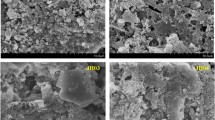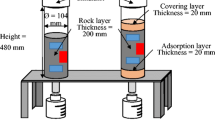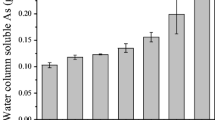Abstract
Purpose
Understanding the mechanisms and kinetics controlling the release of metals from sediment is a prerequisite for evaluating the risk of sediment contaminated by toxic elements. The objectives of this research were to determine the leaching properties of arsenic (As) from stream sediment contaminated by gold mining and to quantify the kinetic rate of As release using a leaching experiment and numerical modeling.
Materials and methods
In this study, we collected surface stream sediment from Jiehe River which was contaminated by gold mining in Zhaoyuan, Shandong Province. Chemical speciation of As was analyzed by a modified three-step BCR sequential extraction procedure. The sediment microscopic morphological characteristics and elemental composition on the surface of the sediment were analyzed by scanning electron microscope-energy dispersive spectrometer (SEM-EDS). Release kinetics of As were studied by a simulated leaching experiment using a stirred-flow reactor and a two-site equilibrium-kinetic model.
Results and discussion
The sediments we studied were significantly contaminated by As, with maximum concentrations of 777.8–3389 mg/kg. Sequential extraction analysis suggested that As contents in weak acid extractable, oxidizable, reducible, and residual forms were 2.6–9.8, 18–79, 2.4–7.1, and 8.7–75 %, respectively. SEM-EDS analysis showed that As on the surface of the sediment was higher than its overall content in all four sediments especially sediment JH27, which has high content of TOC, indicating that abundant As was sorbed or precipitated on the sediment surface. Our two-site equilibrium-kinetic model fits the As release data well and can reproduce the stop-flow experimental results. Kinetic rates obtained from curve fitting showed large variation among sediments for As, indicating different reaction mechanisms.
Conclusions
The release of As from stream sediment contaminated by gold mining was nonequilibrium and time-dependent and might cause long-term pollution to river water. Our two-site model was demonstrated as an effective tool to describe the kinetic release of As from stream sediment to waters.





Similar content being viewed by others
References
Abraitis PK, Pattrick RAD, Vaughan DJ (2004) Variations in the compositional, textural and electrical properties of natural pyrite: a review. Int J Miner Process 74:41–59
Bartal A, Sparks DL, Pesek JD, Feigenbaum S (1990) Analyses of adsorption-kinetics using a stirred-flow chamber. 1. Theory and critical tests. Soil Sci Soc Am J 54:1273–1278
Brannon JM, Patrick WH Jr (1987) Fixation, transformation, and mobilization of arsenic in sediments. Environ Sci Technol 21:450–459
Chandra AP, Gerson AR (2010) The mechanisms of pyrite oxidation and leaching: a fundamental perspective. Surf Sci Rep 65:293–315
Dang DH, Tessier E, Lenoble V, Durrieu G, Omanović D, Mullot J-U, Pfeifer H-R, Mounier S, Garnier C (2014) Key parameters controlling arsenic dynamics in coastal sediments: an analytical and modeling approach. Mar Chem 161:34–46
Deditius AP, Utsunomiya S, Reich M, Kesler SE, Ewing RC, Hough R, Walshe J (2011) Trace metal nanoparticles in pyrite. Ore Geol Rev 42:32–46
Desbarats AJ, Parsons MB, Percival JB (2015) Arsenic mobility in mildly alkaline drainage from an orogenic lode gold deposit, Bralorne mine, British Columbia. Appl Geochem 57:45–54
Equeenuddin SM, Tripathy S, Sahoo PK, Panigrahi MK (2013) Metal behavior in sediment associated with acid mine drainage stream: role of pH. J Geochem Explor 124:230–237
Gaur VK, Gupta SK, Pandey SD, Gopal K, Misra V (2005) Distribution of heavy metals in sediment and water of River Gomti. Environ Monit Assess 102:419–433
Huang JH, Kretzschmar R (2010) Sequential extraction method for speciation of arsenate and arsenite in mineral soils. Anal Chem 82:5534–5540
Hudson-Edwards KA, Houghton SL, Osborn A (2004) Extraction and analysis of arsenic in soils and sediments. Trends Anal Chem 23:745–752
Keon NE, Swartz CH, Brabander DJ (2001) Validation of an arsenic sequential extraction method for evaluating mobility in sediments. Environ Sci Technol 35:2778–2784
Kim J, Hyun S (2015) Nonequilibrium leaching behavior of metallic elements (Cu, Zn, As, Cd, and Pb) from soils collected from long-term abandoned mine sites. Chemosphere 134:150–158
Kwon Y-T, Lee C-W (2001) Ecological risk assessment of sediment in wastewater discharging area by means of metal speciation. Microchem J 70:255–264
Liang N, Yang LY, Dai JR, Pang XG (2011) Heavy metal pollution in surface water of Linglong gold mining area, China, 2011 3rd international conference on environmental science and information application technology esiat. Pt A, Procedia Environ Sci Elsevier Science Bv, Amsterdam 10:914–917
Linge KH (2008) Methods for investigating trace element binding in sediments. Crit Rev Environ Sci Technol 38:165–196
Lu RK (2000) Analytical methods for soil and agro-chemistry. China Agricultural Science and Technology Press, Beijing (in Chinese)
Macgregor K, MacKinnon G, Farmer JG, Graham MC (2015) Mobility of antimony, arsenic and lead at a former antimony mine, Glendinning, Scotland. Sci Total Environ 529:213–222
Mandal B, Suzuki K (2002) Arsenic round the world: a review. Talanta 58:201–235
Molinari A, Ayora C, Marcaccio M, Guadagnini L, Sanchez-Vila X, Guadagnini A (2014) Geochemical modeling of arsenic release from a deep natural solid matrix under alternated redox conditions. Environ Sci Pollut 21:1628–1637
Ng JC, Wang J, Sharim A (2003) A global health problem caused by arsenic from natural sources. Chemosphere 52:1353–1359
NRC (1999) Arsenic in drinking water. National Academic Press, Washington
Nriagu JO, Bhattacharya P, Mukherjee AB, Bundschuh J, Zevenhoven R, Loeppert RH (2007) Arsenic in soil and groundwater: an overview. In: Bhattacharya P, Mukherjee AB, Bundschuh J, Zevenhoven R, Loeppert RH (eds) Arsenic in soil and groundwater environment: biogeochemical interactions, health effects and remediation. Elsevier, Amsterdam, pp 3–60
Paikaray S (2015) Arsenic geochemistry of acid mine drainage. Mine Water Environ 34:181–196
Pandey M, Pandey AK, Mishra A, Tripathi BD (2015) Assessment of metal species in river Ganga sediment at Varanasi, India using sequential extraction procedure and SEM–EDS. Chemosphere 134:466–474
Pueyo M, Mateu J, Rigol A, Vidal M, López-Sánchez JF, Rauret G (2008) Use of the modified BCR three-step sequential extraction procedure for the study of trace element dynamics in contaminated soils. Environ Pollut 152:330–341
Rauret G, López-Sánchez JF, Sahuquillo A, Rubio R, Davidson C, Ure A, Quevauviller P (1999) Improvement of the BCR three step sequential extraction procedure prior to the certification of new sediment and soil reference materials. J Environ Monit 1:57–61
Rubinos DA, Iglesias L, Diaz-Fierros F, Teresa Barral M (2011) Interacting effect of pH, phosphate and time on the release of arsenic from polluted river sediments (Anllns river, Spain). Aquat Geochem 17:281–306
Selim HM, Amacher MC, Iskandar IK (1989) Modeling the transport of chromium (vi) in soil columns. Soil Sci Soc Am J 53:996–1004
Shi Z, Di Toro DM, Allen HE, Ponizovsky AA (2005) Modeling kinetics of Cu and Zn release from soils. Environ Sci Technol 39:4562–4568
Smedley PL, Kinniburgh DG (2002) A review of the source, behaviour and distribution of arsenic in natural waters. Appl Geochem 17:517–568
Sparks DL (1989) Kinetics of soil chemical processes. Academic, San Diego
Teasdale PR, Apte SC, Ford PW, Batley GE, Koehnken L (2003) Geochemical cycling and speciation of copper in waters and sediments of Macquarie Harbour, Western Tasmania. Estuar Coast Shelf Sci 57:475–487
Van Herreweghe S, Swennen R, Vandecasteele C, Cappuyns V (2003) Solid phase speciation of arsenic by sequential extraction in standard reference materials and industrially contaminated soil samples. Environ Pollut 122:323–342
Varol M (2011) Assessment of heavy metal contamination in sediments of the Tigris River (Turkey) using pollution indices and multivariate statistical techniques. J Hazard Mater 195:355–364
Wang S, Mulligan CN (2006) Effect of natural organic matter on arsenic release from soils and sediments into groundwater. Environ Geochem Health 28:197–214
Wenzel WW, Kirchbaumer N, Prohaska T, Stingeder G, Lombi E, Adri-ano DC (2001) Arsenic fractionation in soils using an improved sequential extraction procedure. Anal Chim Acta 436:309–323
Wolkersdorfer C (2008) Water management at abandoned flooded underground mines. Springer, Heidelberg
World Health Organization (WHO) (1993) Guidelines for drinking water quality. Recommendations, 2nd edn. World Health Organization, Geneva
Yang JH, Zhou XH (2000) The Rb–Sr isochron of ore and pyrite subsamples from Linglong gold deposit, Jiaodong Peninsula, eastern China and their geological significance. Chin Sci Bull 45:2272–2277
Yin Y, Allen HE, Huang CP, Sparks DL, Sanders PF (1997) Kinetics of mercury(II) adsorption and desorption on soil. Environ Sci Technol 31:496–503
Zemberyova M, Bartekova J, Hagarova I (2006) The utilization of modified BCR three-step sequential extraction procedure for the fractionation of Cd, Cr, Cu, Ni, Pb and Zn in soil reference materials of different origins. Talanta 70:973–978
Zhang GS, Qu JH, Liu HJ, Liu RP, Li GT (2007) Removal mechanism of As(III) by a novel Fe-Mn binary oxide adsorbent: oxidation and sorption. Environ Sci Technol 41:4613–4619
Zhang H, Yu J, Zhou S (2014) Spatial distribution of As, Cr, Pb, Cd, Cu, and Zn in the water and sediment of a river impacted by gold mining. Mine Water Environ 33:206–216
Acknowledgments
The authors would like to thank Dr. Chengli Qu for chemical analysis. This work was financially supported by the National Natural Science Foundation of China (41271506, 41230858) and Key Research Program of the Chinese Academy of Sciences (KZZD-EW-14). Dr. Hua Zhang was financially supported by the Recruitment Program of Global Young Experts (1000Plan).
Author information
Authors and Affiliations
Corresponding author
Additional information
Responsible editor: Marcel van der Perk
Rights and permissions
About this article
Cite this article
Cai, Y., Mi, Y., Yu, J. et al. Arsenic speciation and kinetic release simulation of stream sediment contaminated by gold mining. J Soils Sediments 16, 1121–1129 (2016). https://doi.org/10.1007/s11368-015-1334-9
Received:
Accepted:
Published:
Issue Date:
DOI: https://doi.org/10.1007/s11368-015-1334-9




